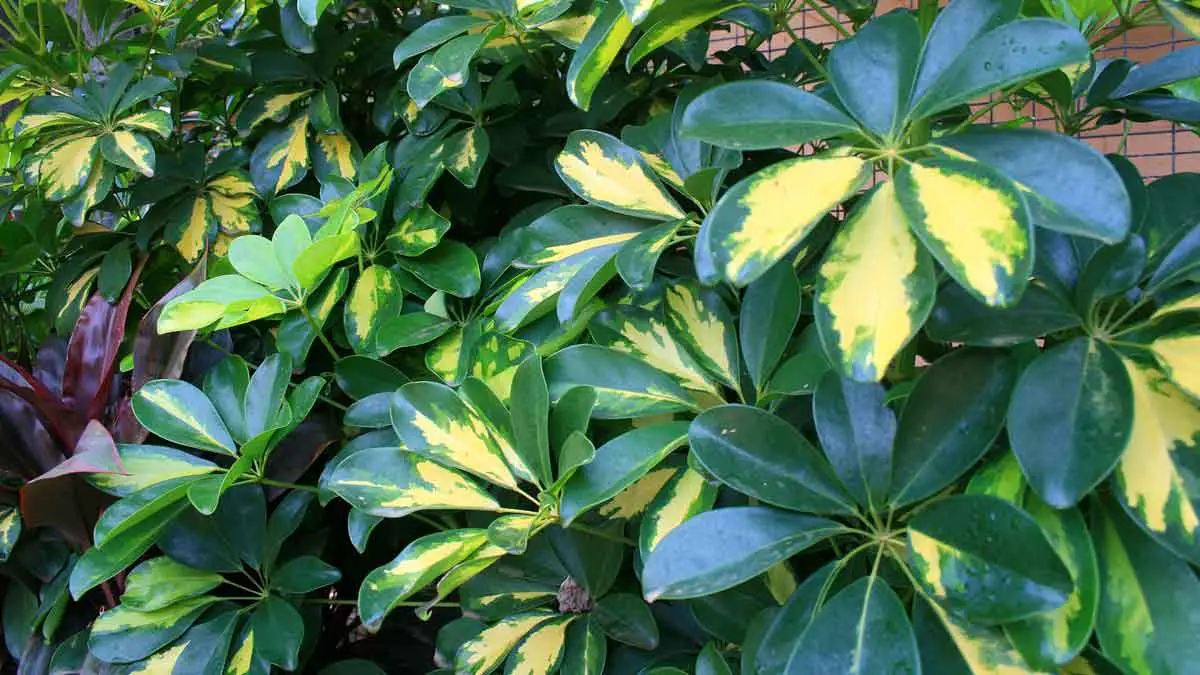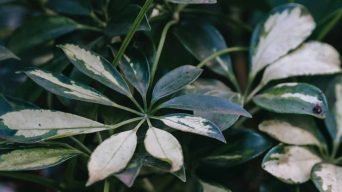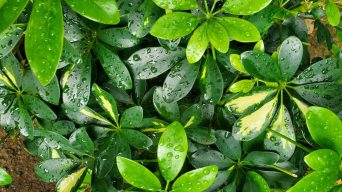Key Takeaways
- Pruning a Schefflera plant promotes healthy growth, improves appearance, and prevents disease and pests.
- Before pruning, assess the plant’s needs, including removing dead or damaged leaves and trimming overgrown branches.
- Use the right tools, such as sharp pruning shears and disinfectant, to prevent disease transmission between cuts. Potting soil and fertilizer also play an essential role in maintaining your plant’s health.
- To avoid over-pruning, cut at the right angle just above a growth node or bud that will help encourage new growth while preserving as much healthy growth as possible. Remember to step back frequently while pruning so you can assess how your cuts impact your plant’s overall appearance.
Pruning your Schefflera plant, popularly known as the umbrella plant, is essential for promoting healthy growth and maintaining its stunning appearance.
As a resilient and low-maintenance houseplant, it’s crucial to understand the proper techniques and practices for pruning to ensure long-lasting vibrancy.
This guide will delve into why pruning is necessary, provide a step-by-step process for effective trimming, and share valuable tips and techniques while highlighting potential mistakes to avoid to achieve an aesthetically pleasing result.
Why Prune A Schefflera Plant?
Pruning a Schefflera plant is crucial for its overall health and appearance, as it promotes healthy growth, prevents diseases and pests, and enhances its aesthetic appeal.
Promote Healthy Growth
Regular pruning of your Schefflera plant is essential to promote healthy growth and maintain overall well-being.
Removing dead, damaged, or diseased leaves and stems encourages the plant to redirect its energy and nutrients toward developing new foliage and branches.
For example, suppose you notice that some parts of your plant have become leggy or sparse due to insufficient light exposure or other unfavorable conditions.
In that case, strategic pruning can stimulate new growth in those areas.
Improve Appearance
Pruning your Schefflera plant promotes healthy growth and significantly enhances its overall appearance.
When left untouched, these plants grow rapidly and may become too large or leggy for their intended space.
One popular approach among plant owners is to create a bonsai-like aesthetic with their Schefflera by removing specific branches and leaves. This encourages an attractive form while showcasing its decorative foliage display more effectively.
The trick lies in balancing maintaining healthy foliage for photosynthesis and achieving the visual appeal you desire.
Prevent Disease And Pests
Pruning a Schefflera plant not only enhances its appearance but also helps prevent diseases and pests that could threaten the health of your beloved indoor companion.
Removing dead, damaged, or diseased leaves and stems eliminates potential breeding grounds for harmful insects such as spider mites, mealybugs, and aphids.
An example of proactive pruning involves the timely removal of drooping or yellowing leaves which may indicate poor health or waterlogging issues.
This practice allows increased airflow through the plant’s interior while encouraging robust growth on healthy branches.
Moreover, checking for discolored or misshapen foliage during routine care sessions can promptly remove infected areas before the disease spreads to other parts of your umbrella plant.
Determine When To Prune
To determine when to prune your Schefflera plant, you should consider the growth pattern and overall health of the plant.
The best time for pruning is generally in late winter or early spring before new growth emerges.
This allows for proper healing of any cuts and encourages healthy new growth.
However, if your Schefflera plant has become leggy with long shoots during the growing season, it may be necessary to shorten them by up to two-thirds, regardless of the time of year.
It’s always a good idea to assess your plant regularly and remove any dead, damaged, or diseased leaves and stems as soon as you spot them to prevent further issues.
Essential Tools And Supplies For Pruning A Schefflera Plant
Having the necessary tools and supplies ready is important to prune your Schefflera plant effectively.
You’ll need sharp pruning shears, protective gloves, disinfectant to prevent disease transmission, potting soil for repotting, and fertilizer to promote new growth.
Choosing The Right Pruning Shears
When it comes to pruning a Schefflera plant, having the right tools is essential for achieving the desired results. One of the most important tools you’ll need is pruning shears, which come in various sizes and shapes.
Bypass pruning shears are considered the best option for pruning Schefflera plants since they’re designed with two sharp blades that make clean cuts through stems without crushing them.
The anvil and ratchet types should be avoided as they can cause damage to the plant’s tissue.
Choosing a pair of shears that feel comfortable in your hand and have a secure grip to avoid accidents while working on your Schefflera plant.
Wearing Gloves
Wearing gloves is an important aspect of pruning a Schefflera plant.
Gloves can protect your hands from the sharp edges of pruning shears and prevent infections caused by open cuts or scratches on your skin.
When choosing gloves for pruning, consider those made from durable materials such as leather or rubber that fit snugly to your hands without being too tight.
Many gardening gloves have reinforced fingertips and palms that offer protection against thorns or other prickly plants.
Using Disinfectant
Disinfecting your pruning tools is a crucial step in pruning your Schefflera plant.
This process helps to prevent the spread of disease-causing organisms and pests that can harm your plant.
To disinfect your tools, you can use either ethanol or isopropyl alcohol solutions.
Wipe down or dip the pruning shears into the solution before starting, and after each cut, ensure that you clean off any sap buildup on the blades to keep them sharp and prevent cross-contamination between cuts.
Remember always to practice safety measures by wearing gloves while working with hazardous substances like disinfectants for protection against harmful chemicals that may cause skin irritation or infection.
Potting Soil
A Schefflera plant thrives in loose, well-draining soil rich in organic matter.
When pruning a Schefflera plant, using the right potting mix is important to ensure the plant has enough nutrients to grow healthy and strong.
A good potting mix for Schefflera should be light and airy, allowing plenty of oxygen to reach the roots. Also, ensure the soil isn’t too compacted or heavy, as this can lead to root rot.
Adding perlite or vermiculite can help create a looser mixture allowing water and air to move freely around the roots while holding onto essential moisture and nutrients needed for growth.
Fertilizer
Fertilizer is an essential tool for pruning a Schefflera plant. The right fertilizer provides the nutrients to promote healthy growth, strong stems, and lush foliage.
A standard diluted indoor plant fertilizer is perfect for the Schefflera plant. Before fertilizing, it is advisable to water your plants to ensure they absorb the nutrients effectively.
Properly fertilizing your Schefflera plant will also help prevent common problems like root rot or nutrient deficiencies, which can lead to stunted growth and discoloration of leaves.
To maintain the excellent health of Schefflera plants, it is important to select a liquid fertilizer that is of high quality and contains all the necessary macro-nutrients, such as nitrogen (N), phosphorus (P), and potassium (K), in equal amounts.
Additionally, the fertilizer should include minor elements such as calcium, magnesium, iron, and manganese.
Step-by-Step Guide To Pruning A Schefflera Plant
Learn how to prune a Schefflera plant with our step-by-step guide correctly.
This includes assessing the plant’s needs, removing dead or damaged leaves, trimming back overgrown branches, shaping the plant, and avoiding over-pruning. Follow our expert tips and techniques for the best results.
Assessing The Plant’s Needs
Before pruning your Schefflera plant, it’s important to assess its needs.
Look at the overall shape and size of the plant, as well as any dead or damaged leaves or stems.
This will help you determine which areas need pruning and how much to trim back.
Additionally, consider whether the plant has become too tall or leggy, which can be remedied by trimming back some of the longer branches.
Remember that pruning a Schefflera plant should not be done all at once – it’s best to prune a little bit over several weeks to avoid shocking the plant.
Removing Dead, Damaged, Or Diseased Leaves And Stems
Removing dead, damaged, or diseased leaves and stems is essential to promote your Schefflera plant’s health.
This prevents diseases from spreading and enhances overall plant growth.
Use a pair of bypass pruning shears to cut items with many dead, broken, or damaged leaves up to half an inch above the nearest healthy stem.
When removing dead or diseased foliage on branches, cut them back to 1/2 inch above the nearest healthy leaf or intersecting stem.
Trimming Back Overgrown Branches
When trimming back overgrown branches on a Schefflera plant, taking time and being strategic in your approach are crucial.
The key is to remove only the necessary parts of the branch while preserving as much healthy growth as possible.
Start by identifying which sections need to be pruned and use sharp pruning shears to make clean cuts right above a leaf node or where a stem meets the main trunk.
Doing this will encourage new growth and help maintain your Schefflera plant’s overall shape and health.
Shaping The Plant
Shaping your Schefflera plant is an essential step in pruning it.
The goal of shaping is to encourage growth and maintain a specific appearance.
To shape the plant, trim the tallest stems to stimulate lateral branching and achieve a fuller look.
One helpful technique for shaping a Schefflera plant is cutting right above leaves at an angle while avoiding damaging nodes on the stem.
This allows for easier healing and promotes faster regrowth.
Avoiding Over-Pruning
Over-pruning can harm your Schefflera plant and prevent it from reaching its full growth potential.
It’s important to remember that pruning should only be done when necessary and in moderation.
To avoid over-pruning, start with small cuts and assess the plant’s response before making further adjustments.
Additionally, don’t prune more than a third of the plant at one time.
Remember that Schefflera plants rebound quickly from pruning, so there’s no need to rush the process.
Tips And Techniques For Pruning A Schefflera Plant
Learn how to correctly prune your Schefflera plant by identifying which parts need trimming, cutting at the correct angle, pruning during the appropriate season, and regularly monitoring growth to maintain its health and beauty.
Identifying Which Parts To Prune
Before you start pruning your Schefflera plant, knowing which parts to prune is important.
Dead or damaged leaves and stems should be removed as soon as possible, as they can attract pests and diseases that may harm the rest of the plant.
When shaping your Schefflera plant, focus on removing any crossing or rubbing branches that could damage each other over time.
You may also want to trim back long shoots to encourage a more compact shape.
Remember to step back frequently while pruning so you can assess how your cuts impact your plant’s overall appearance.
Cutting At The Right Angle
Cutting at the right angle is vital for optimal results when pruning a Schefflera plant.
This means making clean cuts just above a growth node or bud that will help encourage new growth in the desired direction.
Additionally, cutting at the correct angle also helps promote quicker healing of the pruned area.
Using sharp pruning shears and making straight cuts perpendicular to the stem will ensure that your Schefflera looks neat and tidy after pruning.
Pruning During The Right Season
To prune a Schefflera plant during the right season is crucial for its growth and development.
Pruning during the growing season, usually in spring, encourages the plant to push out new growth and can result in a denser, bushier shape.
Cutting back Schefflera just above a growth node helps control height and ensures better overall growth.
Leaving 2 or 3 leaf nodes on each stem while pruning allows fresh new growth to occur, which can help rejuvenate an older plant that has become leggy or overgrown.
Monitoring Plant Growth
It’s important to keep an eye on the growth of your Schefflera plant after pruning.
This will ensure that it continues to grow healthy and maintain its shape.
Another way is observing yellowing or wilting leaves, which may indicate a lack of nutrients, overwatering, or other issues.
Remember that different types of Schefflera plants have unique characteristics and may require specific care instructions.
Common Mistakes To Avoid When Pruning A Schefflera Plant
Avoid over-pruning and cutting too low when pruning a Schefflera plant is important.
These actions can cause harm to the plant’s growth.
Over Pruning
Over-pruning is one of plant owners’ most common mistakes while pruning their Schefflera plant.
While trimming dead, damaged, or diseased leaves and stems is important, cutting off too much can harm the plant’s overall growth and health.
Over-pruning can leave the plant looking sparse with fewer leaves and branches, impacting its ability to photosynthesize effectively.
To avoid over-pruning, start by assessing your Schefflera’s needs carefully before you begin trimming.
It’s essential not to prune more than one-third of a Schefflera’s foliage at any given time, as this can lead to excessive stress on the tree that could take weeks or even months to recover fully.
In some cases, overpruned plants may become more susceptible to diseases or pests, making them less resilient in the long run.
Cutting Too Low
Cutting too low is one of the most common mistakes people make when pruning a Schefflera plant.
This can have detrimental effects on the health and growth of your plant.
When you cut too low, you risk removing more than necessary, which could damage the main stem and hinder its growth potential.
To avoid this mistake, it’s important to identify where to make cuts before starting your pruning process, always cutting just above the leaf nodes or healthy stems.
Remember that pruning should be done with care to promote healthy growth without causing damage.
Schefflera plants are delicate and require care at every step of their maintenance routine.
Ignoring Warning Signs
One common mistake to avoid when pruning a Schefflera plant is to overlook warning signs such as changes in leaf color or small yellow areas, which can indicate rot at the base of the plant.
Inspecting the leaves and stems before starting pruning activities and removing any dead, damaged, or diseased parts by cutting them off close to their origin point.
Another crucial aspect not to ignore is growth patterns that veer off course from its required shape and height.
If you encounter more than a few dry or yellow leaves in your houseplant’s canopy, it may be time for corrective actions like cleaning up dead spots with insecticidal soap.
Remember that improper watering habits can lead to root rot, so checking and adjusting moisture levels accordingly is vital while being cautious about overwatering during colder months.
Neglecting Tool Maintenance
One of the common mistakes to avoid when pruning a Schefflera plant is neglecting tool maintenance.
This mistake can result in jagged cuts that damage the plant, leading to infections and diseases.
It’s essential to keep your pruning shears sharp by regularly sharpening them using a file or stone.
You should also oil them after sharpening to prevent rust and corrosion.
Additionally, disinfect your tools with rubbing alcohol before starting any pruning project to reduce the chances of transmitting disease from one plant to another.
Final Thoughts
Pruning a Schefflera plant may initially seem daunting, but it can be an easy and rewarding task with the right tools and techniques.
By removing dead or diseased leaves and trimming back overgrown branches, you can promote healthy growth and improve the appearance of your plant.
Remember to identify which parts to prune, cut at the right angle, and avoid over-pruning.
And don’t forget: proper watering and fertilization are key to keeping your Schefflera plant thriving all year round.







